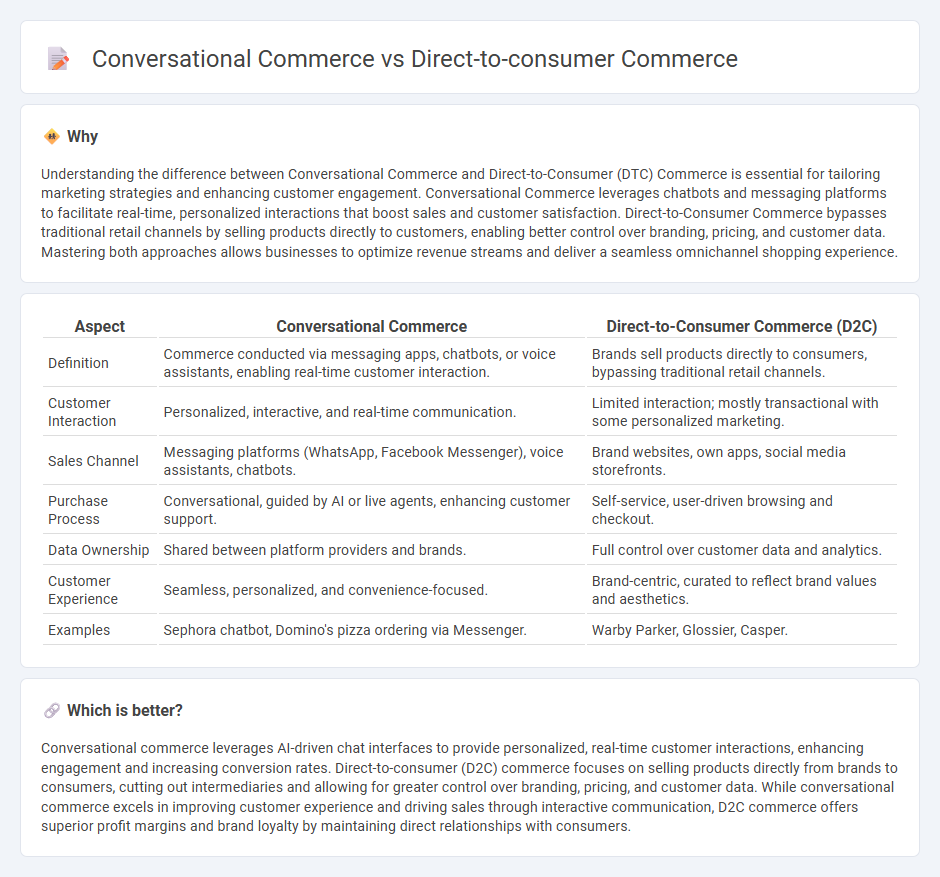
Conversational commerce leverages messaging apps, chatbots, and voice assistants to facilitate personalized customer interactions and seamless transactions, enhancing user engagement and satisfaction. Direct-to-consumer (DTC) commerce bypasses traditional retail channels by selling products directly to consumers through brand-owned online stores, fostering stronger customer relationships and higher profit margins. Explore deeper insights into how these innovative commerce models are reshaping the digital marketplace.
Why it is important
Understanding the difference between Conversational Commerce and Direct-to-Consumer (DTC) Commerce is essential for tailoring marketing strategies and enhancing customer engagement. Conversational Commerce leverages chatbots and messaging platforms to facilitate real-time, personalized interactions that boost sales and customer satisfaction. Direct-to-Consumer Commerce bypasses traditional retail channels by selling products directly to customers, enabling better control over branding, pricing, and customer data. Mastering both approaches allows businesses to optimize revenue streams and deliver a seamless omnichannel shopping experience.
Comparison Table
| Aspect | Conversational Commerce | Direct-to-Consumer Commerce (D2C) |
|---|---|---|
| Definition | Commerce conducted via messaging apps, chatbots, or voice assistants, enabling real-time customer interaction. | Brands sell products directly to consumers, bypassing traditional retail channels. |
| Customer Interaction | Personalized, interactive, and real-time communication. | Limited interaction; mostly transactional with some personalized marketing. |
| Sales Channel | Messaging platforms (WhatsApp, Facebook Messenger), voice assistants, chatbots. | Brand websites, own apps, social media storefronts. |
| Purchase Process | Conversational, guided by AI or live agents, enhancing customer support. | Self-service, user-driven browsing and checkout. |
| Data Ownership | Shared between platform providers and brands. | Full control over customer data and analytics. |
| Customer Experience | Seamless, personalized, and convenience-focused. | Brand-centric, curated to reflect brand values and aesthetics. |
| Examples | Sephora chatbot, Domino's pizza ordering via Messenger. | Warby Parker, Glossier, Casper. |
Which is better?
Conversational commerce leverages AI-driven chat interfaces to provide personalized, real-time customer interactions, enhancing engagement and increasing conversion rates. Direct-to-consumer (D2C) commerce focuses on selling products directly from brands to consumers, cutting out intermediaries and allowing for greater control over branding, pricing, and customer data. While conversational commerce excels in improving customer experience and driving sales through interactive communication, D2C commerce offers superior profit margins and brand loyalty by maintaining direct relationships with consumers.
Connection
Conversational commerce leverages real-time messaging platforms to enhance direct-to-consumer (DTC) commerce by providing personalized customer interactions that drive immediate purchasing decisions. Both models prioritize direct engagement between brands and consumers, eliminating intermediaries to improve customer experience and increase conversion rates. Integrating chatbots and AI in conversational commerce streamlines the DTC sales funnel, fostering loyalty and boosting revenue.
Key Terms
Customer Experience
Direct-to-consumer (D2C) commerce streamlines customer interactions by eliminating intermediaries, offering personalized browsing and purchasing experiences on brand-owned platforms, which enhances control over the customer journey and brand consistency. Conversational commerce leverages AI-driven chatbots and messaging apps to facilitate real-time, interactive shopping experiences, improving responsiveness, engagement, and personalized support. Explore how these strategies redefine customer experience and drive sales transformation.
Personalization
Direct-to-consumer commerce emphasizes personalized product recommendations and curated shopping experiences by leveraging customer data and behavior. Conversational commerce enhances personalization through real-time interaction via chatbots and messaging platforms, allowing tailored responses and instant support to meet individual preferences. Explore how these innovative approaches transform customer engagement and boost sales efficiency.
Sales Channel
Direct-to-consumer commerce leverages online platforms and brand-owned websites to sell products directly to customers, enhancing control over branding and customer data. Conversational commerce utilizes messaging apps, chatbots, and voice assistants to facilitate personalized, real-time shopping experiences through interactive communication. Explore the key differences and benefits of each sales channel to optimize your e-commerce strategy.
Source and External Links
How the Direct-to-Consumer (DTC) Business Model Works - The DTC model involves selling products directly from brands to consumers online, bypassing traditional intermediaries like wholesalers or physical stores, which often results in lower costs for both manufacturer and consumer compared to B2C models.
Direct-to-consumer - Wikipedia - Direct-to-consumer sales bypass third-party retailers and wholesalers by selling directly to customers, commonly online, and gained popularity during the dot-com bubble, involving brands like Allbirds and Warby Parker.
What Is Direct-to-Consumer? Everything You Need To Know (2024) - DTC brands sell directly to customers via online platforms, controlling fulfillment and marketing, focusing on customer relationships, personalized experiences, and often utilizing loyalty programs and community-building strategies to drive retention and growth.
 dowidth.com
dowidth.com